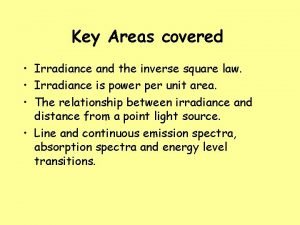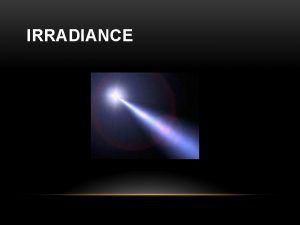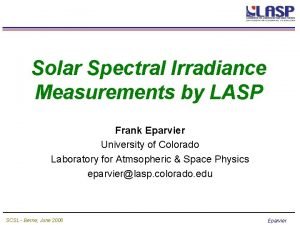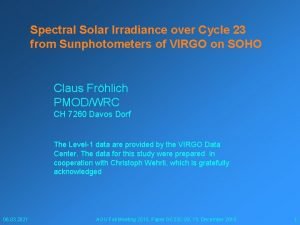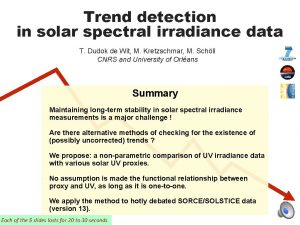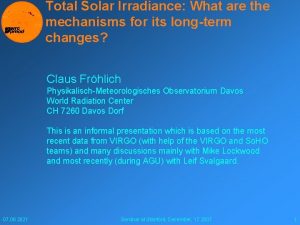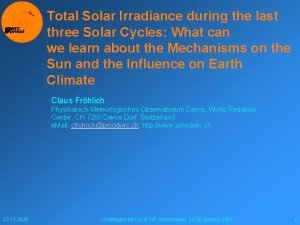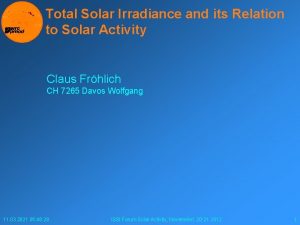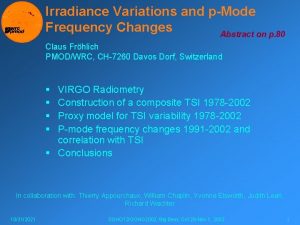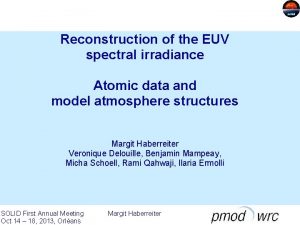Mechanisms of Solar Spectral Irradiance Variations Sami K





















- Slides: 21

Mechanisms of Solar Spectral Irradiance Variations Sami K. Solanki Max Planck Institute for Solar System Research

Which physical processes can lead to solar irradiance variations? n Magnetic field Varies on time scales of minutes-millenia & likely longer n Surface fields cause irradiance variations n Sub-surface fields are a possible cause, but no evidence n n Convection On time-scales of minutes-days: granulation & possibly supergranulation cause random fluctuations n Variations on longer timescales? No evidence, but possible n n Oscillations + rotation ≈ 107 p-modes with periods ≈ 5 min; well visible in irradiance (VIRGO) n Longer-period modes: r-modes (rotational modes) have been theoretically predicted. Unknown influence on irradiance ? ? n n Diameter changes (by whichever means) n Effective temperature changes (by whichever means)

Solar spectral irradiance Solar radiance at different wavelengths arises in different atmospheric layers n Spctral lines are formed higher than the continuum formation heights shown here n Spectral irradiance is further integrated over the solar disc n Solar spectrum Height of formation, brightness temp, opacities UV IR 1. 6μm

Sources of spectral irradiance variations n Magnetic field Magnet field in solar atmosphere heats higher layers more stronger variability in UV (also slightly in very far IR) n Magnetic field in solar interior cannot explain variability in UV n n Convection affects mainly lower atmospheric layers, but may also reduce heating of chromosphere (acoustic wave excitation). Not clear if strong variability in UV spectral lines can be explained Oscillations p-modes: too short periods irrelevant for climate studies n Longer-period modes, e. g. r-modes (torsional modes): effect on SSI unknown, but possibly simply effective temperature change n n Diameter changes cannot explain enhanced UV variability n Effective temperature changes cannot explain UV variability

n

Sources of spectral irradiance variations n Magnetic field at solar surface: Not only are such fields the most successful in reproducing TSI variations (SATIRE), but also the strongest candidates to explain an enhanced TSI variation in the UV (only changes in convection could indirectly also play a role, although it remains unclear how large this could be) n For rest of talk I’ll Concentrate on surface magnetic fields n n Which magnetic features cause TSI and SSI variations? Neglecting extreme wavelengths (λ < Ly α, radio frequencies, dominated by loops, flares etc. ), the main features are: n Sunspots n Faculae, plage and network n

Sunspots: the Wilson effect n Near solar limb umbra and centre-side penumbra disappear We see 400 -800 km deeper into sunspots than in photosphere n B 2/8π + p = const. p lower in spot than outside density lower opacity lower we see deeper into spot Wilson (18 th century) Mathew et al. 2004

Why are sunspots dark? n The strong nearly vertical magnetic field, not allowing motions across the field lines, basically quenches convection inside the spot (specially in umbra) n Since convection is the main source of energy transport just below the surface, less energy reaches the surface through the spot dark β >1 β <1

Why are sunspots dark? II n Where does the energy blocked by sunspots go? Spruit (1982) Short diffusive timescale of convection zone (CZ): blocked heat is redistributed in CZ within 1 month – 1 year ( at most only very weak bright rings around sunspots) Large heat capacity of CZ: the additional heat does not lead to a measurable increase in temperature n Long time scale for thermal relaxation of the CZ (Kelvin. Helmholtz timescale): 105 years excess energy is released almost imperceptibly (Kelvin- Helmholtz timescale: how long can Sun shine using only its gravitational energy) n Drop in TSI during passage of spots: model is basically correct

Non-spot fields n Sunspots cover in general <0. 2% of solar surface n What about the remaining 99. 8%? n What are plage or faculae & network composed of?

Facular fields are composed of magnetic elements, bright, thin (diameter <300 km) flux tubes or flux sheets

Magnetic elements: brightness n Convective energy flux (red arrows) quenched by magnetic field heat blocked n Radiation inflow (heat flux) into evacuated flux tube through hot walls (yellow arrows) Enhanced emission. Inflow wins since FTs are narrow: diameter ~ Wilson depress n Excess energy comes partly from deep CZ, over Kelvin. Helmholtz timescale n Waves excited in magn. elem. can heat chromosphere (brown cloud)

Why are faculae best seen near limb? The Sun in White Light, with limb darkening removed MDI on SOHO

Flux-tube brightening near limb n FTs are evacuated due to pressure balance hot walls n Most energy radiates away from FTs through their hot walls n FTs appear brightest when hot walls are well seen, i. e. near limb (closer to limb for larger tubes)

Facular brightening Limb Center (continuum image: SST, La Palma =60° =488 nm) High resolution observations reveal 3 D appearance of faculae (Lites et al. 2004)

Faculae lead to brightening of whole Sun Dip due to presence of small spot

Brightness contrast in visible vs. Size Uncertain I/IQS Turbul. Magn. Pores Sunspots fields elements spots umbrae Exact numbers depend on λ, μ, resolution, etc.

Temperature stratifications of quiet Sun, sunspot, magnetic element Empirical 1 -D model atmospheres n Dashed: Quiet Sun n Solid: sunspot n Dot-dashed: active region plage, magnetic element n Plage is hottest everywhere in atmosphere n Sunspot cold (dark) in photosphere, but hot (bright) in upper chromosphere & transition region

What about brightness of individual magnetic elements? n Results from Sunrise, balloon-borne observ. First resolved magnetic elements (Lagg et al. 2010) n Magnetic elements are bright in the UV (200 -400 nm), quite strongly n in the visible (525 nm), more weakly, but still clearly n Plot: disk centre. Near limb magn. els. are brighter n

Summary n For timescales up to the solar cycle, SSI variations must overwhelmingly be produced by magnetic fields at solar surface n We expect this to be true also on longer timescales, but cannot rule out other mechanisms (e. g. , convection, oscillations) n How magnetic features change the solar spectrum depends on their size: n Large features (spots, pores): main effect is through inhibition of convective energy transport by the field darkening, roughly according to Planck function of lower temperature n Small features (magnetic elements): both through their geometry (Wilson depression) and through heating of the upper photosphere and chromosphere brightening depends strongly on distance to limb and wavelength (λ in the UV are particularly affected) n Small features seem to be bright also in the visible, i. e. deep layers!

 Inverse square law irradiance
Inverse square law irradiance Irradiance environment map
Irradiance environment map Global illumination vray
Global illumination vray Irradiance to radiance conversion
Irradiance to radiance conversion An efficient representation for irradiance environment maps
An efficient representation for irradiance environment maps Inexhaustible source of energy
Inexhaustible source of energy Wholesale solar controller
Wholesale solar controller Stabilization of transistor
Stabilization of transistor Linked list variations
Linked list variations Sine rule and cosine rule
Sine rule and cosine rule Kwhl chart example
Kwhl chart example Natural variations operations management
Natural variations operations management Lovelock chapter 9
Lovelock chapter 9 Possible variations
Possible variations Joint variation examples grade 9
Joint variation examples grade 9 Super bowl squares variations
Super bowl squares variations Direct variation linear function
Direct variation linear function Valuation of variations
Valuation of variations Variations de stock
Variations de stock Cultural variations in attachment
Cultural variations in attachment Language variation and change
Language variation and change Variations pathologiques de la température
Variations pathologiques de la température
